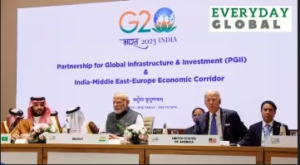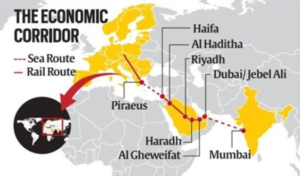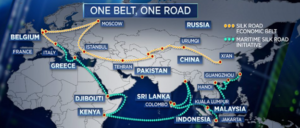India-Middle East- Europe economic corridor- GPII.
Relevance
- GS 2: Bilateral, Regional and Global Groupings and Agreements involving India
- Tags: #BRI #G20Summit #PGII #UPSC #PMModi #Editorial Analysis #IndianExpress
Why in the News?
During the G20 Summit in New Delhi, a significant development unfolded as India, the US, Saudi Arabia, the European Union, the UAE, France, Germany, and Italy joined forces to ink a Memorandum of Understanding (MoU), paving the way for the creation of the India – Middle East – Europe Economic Corridor (IMEC).
Inauguration of PGII: Unveiling a Counter to BRI
The Partnership for Global Infrastructure Investment (PGII) was officially launched on March 14, 2023, during the G20 Summit in New Delhi.
- This initiative, led by Western nations, aims to provide funding for global infrastructure projects, serving as a response to China’s Belt and Road Initiative (BRI).
- Prime Minister Narendra Modi expressed India’s commitment to leveraging PGII to address infrastructure deficits in countries of the Global South.
- In June 2021, at the G7 summit in the UK, US President Joe Biden introduced the Build Back Better World (B3W) framework, envisioning a global infrastructure plan.
- Progress was slow until 2022 when, at the G7 summit in Germany, the Partnership for Global Infrastructure Investment (PGII) was formally launched.
Objectives of PGII
- This collaborative initiative, comprising G7 nations and the EU, seeks to finance infrastructure projects in developing countries through a blend of public and private investments.
- President Biden pledged on social media, “Collectively, we aim to mobilize nearly $600 billion from the G7 by 2027 to invest in critical infrastructure that improves lives and delivers real gains for all of our people.”
- PGII represents a concerted effort to address global infrastructure needs and promote development on an international scale.
- The G7’s PGII initiative was crafted as an alternative to China’s BRI, aiming to provide funding for global infrastructure projects.
Funding Sources for PGII
- The Partnership for Global Infrastructure Investment (PGII) is set to combine public and private funds.
- G7 nations are actively seeking private sector investments, including pension funds and insurance companies.
- Additionally, established institutions like the World Bank and the Asian Infrastructure Investment Bank will be leveraged.
- PGII’s core focus aligns with UN Sustainable Development Goals, emphasizing transparency, and adhering to rigorous standards for environmental and social impact assessment.
PGII: Advancing Infrastructure in Developing Nations
- European Commission chief Ursula von der Leyen announced that the India-Middle East-Europe Economic Corridor (IMEC) represents a progression in the Partnership for Global Infrastructure Investment (PGII), launched by von der Leyen, President Biden, and President Joko Widodo of Indonesia during the G20 summit in Bali.
- IMEC unveiled various projects in Indonesia, including clean energy and telecommunications initiatives.
- India also participated, securing over $15 million in investments from the US International Development Finance Corporation (DFC) for health infrastructure, supporting eye clinics and women’s hygiene product manufacturing to aid underserved communities in non-metro areas.
- The EU’s Global Gateway program aims to mobilize €300 billion in investments for vital connectivity projects between 2021 and 2027, with half allocated to Africa.
- The initiative encompasses over 90 projects across Africa, Latin America, the Caribbean, Asia-Pacific, and the Western Balkans, focusing on enhancing global infrastructure and connectivity.
Belt and Road Initiative (BRI)
The Belt and Road Initiative (BRI) is China’s extensive, long-term economic and political strategy aimed at promoting economic development domestically and in emerging nations while bolstering China’s global influence.
Initiation
- President Xi Jinping launched the BRI in 2013, outlining two primary developmental corridors:
- the “Silk Road Economic Belt” connecting China with Central Asia and Europe via overland routes,
- And the “21st-Century Maritime Silk Road” extending through South and Southeast Asia to Africa and Latin America via maritime routes.
Objectives
- The core objective of the BRI is to address the significant infrastructure needs of developing countries by leveraging China’s industrial overcapacity and global ambitions.
- This initiative generates new infrastructure projects for Chinese companies.
- Beyond economic development, the BRI aims to extend China’s global sphere of influence by aligning partner countries with China’s long-term strategic interests.
Challenges and Setbacks
- The BRI encountered challenges, particularly due to the COVID-19 pandemic, leading to a nearly 50% drop in China’s annual investments in BRI countries to approximately $60 billion.
Future Significance
- Despite setbacks, the BRI is expected to remain a vital tool of China’s foreign policy and economic strategy, with 149 countries having joined the initiative as of July 2022 through Memorandums of Understanding.
Criticisms regarding China’s BRI
- Debt Trap Diplomacy: China’s BRI often involves extending substantial loans to developing nations. When these countries struggle to repay, China may acquire strategic assets. For instance, Sri Lanka’s Hambantota Port was leased to China for 99 years in exchange for debt relief, raising sovereignty concerns.
- Lack of Transparency: Critics argue that BRI lacks transparency, leading to corruption and environmental harm. The Karot Hydropower Project in Pakistan faced criticism for its opaque financing and environmental consequences.
- Environmental Impact: Large-scale BRI infrastructure projects like dams and railways can harm the environment. The China-Laos railway raised concerns about its impact on biodiversity and habitats.
- Social and Labor Issues: BRI projects are criticized for poor treatment of local laborers and communities. Reports of inadequate wages and displacement emerged in various initiatives.
- Geopolitical Ambitions: Some view BRI as China’s geopolitical tool. India is concerned about the China-Pakistan Economic Corridor’s route through Pakistan-occupied Kashmir.
- Quality and Standards: Critics argue that BRI projects may not meet international quality standards. The Maputo-Catembe Bridge in Mozambique faced criticism for construction quality and safety concerns.
- Overcapacity: China’s excess industrial capacity has raised doubts about whether BRI addresses recipient countries’ true infrastructure needs.
- Sovereignty Concerns: Nations fear economic dependence on China through BRI investments, potentially compromising sovereignty.
- Lack of Consultation: China’s insufficient consultation with local communities and governments has led to social unrest in some cases.
- Corruption: Allegations of corruption involving Chinese companies in BRI projects have raised ethical concerns.
BRI vs. PGII: Infrastructure Investment
| Aspect | Belt and Road Initiative (BRI) | Partnership for Global Infrastructure Investment (PGII) |
| Initiation Year | 2013 | Formally launched in 2022 |
| Origin | China | G7 Countries and the European Union |
| Objective | Enhance global trade and connectivity through infrastructure investments | Fund critical infrastructure projects in developing nations through public and private investments |
| Geographical Focus | Global, spanning Asia, Europe, Africa, and beyond | Global, with a particular focus on Africa |
| Funding Mechanism | Provides loans and investments to partner countries for infrastructure projects, often carried out by Chinese companies | Aims to mobilize investments through public and private sectors, focusing on sustainable and resilient infrastructure |
| Debt Concerns | Criticized for potentially burdening partner countries with unsustainable debt | PGII aims for transparent, responsible financing to avoid debt-related issues |
| Environmental Considerations | Concerns raised about environmental degradation in some BRI projects | PGII emphasizes climate change-resilient infrastructure |
| Transparency and Governance | Criticized for lack of transparency and governance standards | PGII emphasizes transparency and adherence to global standards |
| Political and Territorial Issues | Controversial projects such as the China-Pakistan Economic Corridor (CPEC) have sparked territorial disputes (e.g., India’s opposition) | PGII avoids politically sensitive projects |
| Beneficiaries | China has asserted economic gains and job creation | PGII focuses on gender equality, health infrastructure, and sustainable development |
| Global Impact | World Bank report suggests BRI could increase global trade and income if challenges are addressed | PGII aims to promote global development and cooperation |
| Views on Geopolitical Motives | Critics suggest BRI has geopolitical objectives | PGII emphasizes cooperation and denies geopolitical motives |
| India’s Position | Opposed, primarily due to the China-Pakistan Economic Corridor (CPEC) and territorial concerns | Supportive of transparent and sovereignty-respecting connectivity initiatives |
| World Bank Assessment | Some economies at risk of unsustainable debts like Sri Lanka | Potential to increase global trade and real income if environmental, debt, and corruption issues are resolved |
| Chinese Company Involvement | Chinese companies often awarded contracts | Involves a collaborative effort with multiple nations |
Partnership for Global Infrastructure Investment (PGII) represents a concerted effort by G7 countries and other partners to offer an alternative to China’s Belt and Road Initiative (BRI) for funding infrastructure projects. While both initiatives aim to enhance global connectivity, the PGII emphasizes transparency, climate resilience, and development objectives. As it gains momentum, the PGII has the potential to provide diverse infrastructure options to countries, fostering healthy competition and benefiting all stakeholders.
Source: Indian Express
Mains Question
Analyze the reasons behind the establishment of PGII as an alternative to the BRI. What concerns and criticisms have been raised regarding China’s BRI?






